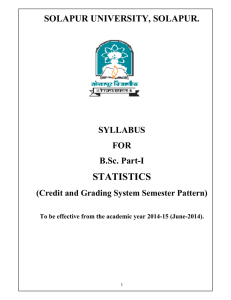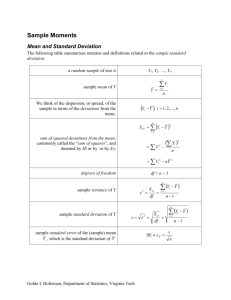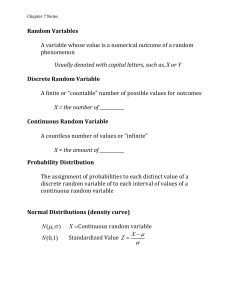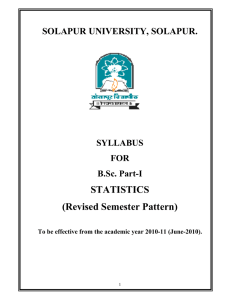Revised Semester Pattern Syllabus STATISTICS w.e.f. June 2013
advertisement
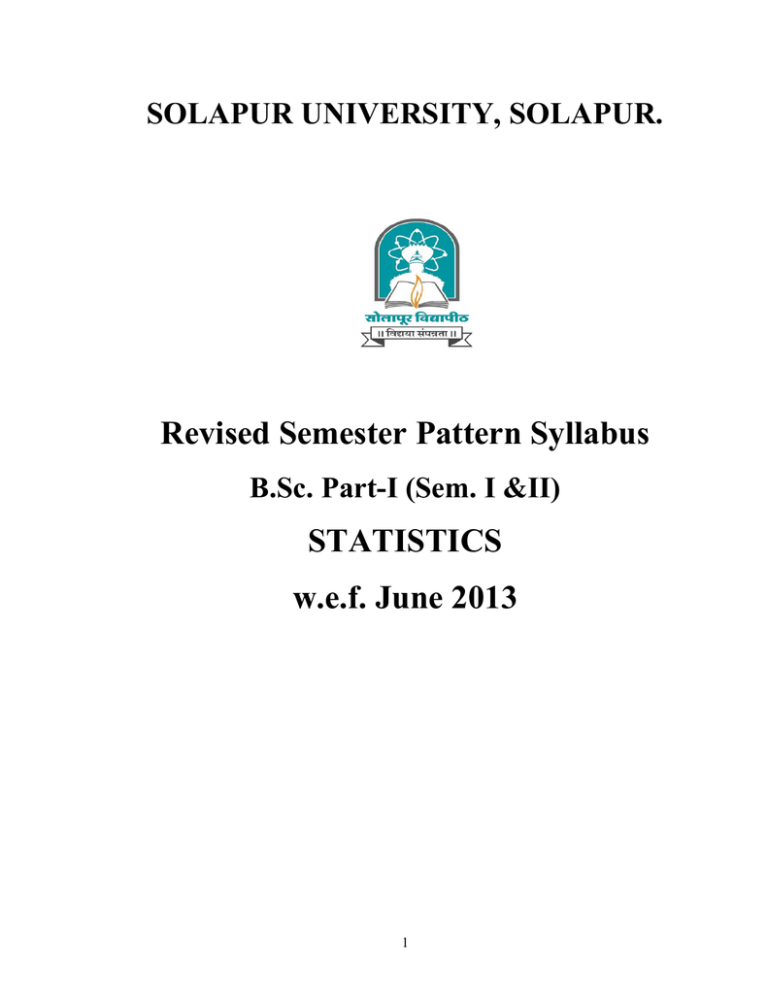
SOLAPUR UNIVERSITY, SOLAPUR. Revised Semester Pattern Syllabus B.Sc. Part-I (Sem. I &II) STATISTICS w.e.f. June 2013 1 SOLAPUR UNIVERSITY, SOLAPUR. B.Sc. Part-I STATISTICS Semester Pattern Syllabus (To be implemented from June, 2013) Title of the course: B.Sc. Part-I Statistics (Semesters I and II) Introduction : Statistics is the study of the collection, organization, analysis, interpretation, and presentation of data. Statistics plays a vital role in every fields of human activity. Statistics has important role in determining the existing position of per capita income, unemployment, population growth rate, housing, schooling medical facilities etc…in a country. Now statistics holds a central position in almost every field like Industry, Commerce, Trade, Physics, Chemistry, Economics, Mathematics, Biology, Botany, Psychology, Astronomy etc…, so application of statistics is very wide. Today, statistics is increasingly becoming important in a number of professions, and people from all walks of life actively use statistics, from politicians and business leaders to engineers and biologists. There are at least three reasons for studying statistics: (1) data are everywhere, (2) statistical techniques are used to make many decisions that affect our lives, and (3) no matter what your career, you will make professional decisions that involve data. An understanding of statistical methods will help you make these decisions more effectively. Eligibility of the course : Standard XII Science or equivalent examination passed. Duration : One year divided into two semesters. Medium of instruction : English Structure of the course: Semester No. I II I and II Paper No. STATISTICS PAPER-I STATISTICS PAPER-II STATISTICS PAPER-III STATISTICS PAPER-IV STATISTICS PRACTICAL Title of the Paper Marks Descriptive Statistics-I 50 Probability and Probability Distributions-I 50 Descriptive Statistics-II 50 Probability and Probability Distributions-II 50 Statistics Practical Paper-I (Annual Examination) 50 2 Teaching Periods: 1. Total teaching periods for Two Theory Papers are five periods per week in each semester. 2. Total teaching periods for Practical-I are four periods per week per batch of 20 students. Duration of examination: 1. Two hours duration for each theory paper of 50 marks. 2. Four hours duration for Practical Paper-I (Annual Examination) for a Batch of 20 students. Syllabus: SEMESTER-I STATISTICS PAPER – I: Descriptive Statistics-I STATISTICS PAPER –II: Probability and Probability Distributions-I Objectives: The main objective of this course is to acquaint students with some basic concerns statistics. They will be introduced to some elementary statistical methods of analysis and Probability. At the end of this course students are expected to be able : 1. To prepare frequency distribution and represent it by graphically with the help of tables. 2. To compute various measures of central tendency, dispersion, moments, Skewness, Kurtosis and to interpret them. 3. To distinguish between random and non-random experiments. 4. To find the probabilities of the events. STATISTICS PAPER – I (Descriptive Statistics-I) Unit -1 Nature of Data : (8) 1.1 Population and Sample. 1.2 Meaning of primary and secondary data. 1.3 Qualitative data (Attributes) : Nominal Scale and Ordinal scale. 1.4 Quantitative data (Variables): Interval Scale and ratio scale, discrete and continuous variables, raw data. 1.5 Classification of data : Discrete and continuous frequency distribution, inclusive and exclusive methods of classification, cumulative frequency distribution, relative frequency. 3 1.6 Graphical representation of data : Histogram, frequency polygon, frequency curve and Ogive curves. 1.7 Illustrative Examples. Unit – 2 Measures of Central Tendency : (10) 2.1 Concept of central tendency of statistical data, statistical average, requirements of good statistical average. 2.2 Arithmetic Mean (A. M.) : Definition, effect of change of origin and scale, deviation of observations from A. M., Mean of pooled data, weighted A. M. 2.3 Geometric Mean (G. M.) : Definition 2.4 Harmonic Mean (H. M.) : Definition 2.5 Relation : A. M. ≥ G. M. ≥ H. M. (Proof for n = 2, positive observations) G.M. = A.M. × H.M. (Proof for n = 2, positive observations) 2.6 Median : Definition, Derivation of formula for grouped frequency distribution. 2.7 Mode : Definition, Derivation of formula for grouped frequency distribution. 2.8 Empirical relation between Mean, Median and Mode. 2.9 Partition Values : Quartiles, Deciles and Percentiles. 2.10 Graphical method of determination of Median, Mode and Partition values. 2.11 Situations where one kind of average is preferable to others. 2.12 Examples to illustrate the concept. Unit – 3 Measures of Dispersion : (9) 3.1 Concept of dispersion, Absolute and Relative measures of dispersion, Requirements of a good measure of dispersion. 3.2 Range : Definition, Coefficient of range. 3.3 Quartile Deviation (Semi-interquartile range) : Definition, coefficient of Q.D. 3.4 Mean Deviation: Definition, coefficient of M. D., Minimal property of M.D. (Statement only). 3.5 Mean Square Deviation: Definition, Statement and proof of minimal property of M. S. D. 3.6 Variance and Standard Deviation : Definition, Statement and proof of effect of change of origin and scale on S.D. and Variance (for proof take individual data of n observations x1 , x2 ,....xn and d i = xi − A ), S. D. of pooled data (without proof). h 3.7 Coefficient of Variation : Definition and use. 4 3.8 Comparison of absolute and relative measures of dispersion. 3.9 Examples to illustrate the concept. Unit – 4 Moments, Skewness and Kurtosis : (8) 4.1 Moments : Raw moments ( μ r′ ) and central moments ( μ r ) and factorial moments ′ ) ) for ungrouped and grouped data. ( μ (r 4.2 Effect of change of origin and scale on moments, relation between central and raw moments (up to 4th order), relation between raw and factorial moments (up to 2nd order). 4.3 Sheppard’s correction, need of Sheppard’s correction. 4.4 Skewness : Concept of Skewness of a frequency distribution, Types of Skewness and its interpretation. 4.5 Bowley’s coefficient of skewness, Karl Pearson’s coefficient of skewness, Measure of skewness based on moments. 4.6 Kurtosis : Concept of kurtosis of a frequency distribution, Types of kurtosis and its interpretations. 4.7 Measure of kurtosis based on moments. 4.8 Illustrative Examples. Books Recommended 1. Bhat B. R., Srivenkatramana, T and Madhava K. S. (1996) : Statistics : A Beginner's Text Vol. 1, New Age International (P), Ltd. 2. Croxton F. E., Cowden D. J. and Kelin S. (1973) : Applied General Statistics, Prentice Hall of India. 3. Goon, Gupta and Dasgupta : Fundamentals of Statistics Vol. I and II, World Press, Calcutta. 4. Gupta S. P : Statistical Methods. 5. Snedecor G. W.and Cochran W. G. (1967) : Statistical Methods Lowa State University Press. 6. Walker and Lev : Elementary Statistical Methods. 7. Applied Statistics : Gupta and Kapoor. 8. Dixit P. G. and Thigale T. K. : A Text Book of Statistics Paper - I 9. Fundamentals of Mathematical statistics: Gupta & Kapoor. 10. Kumbhojkar G. V. Mathematical Statistics Paper I 5 STATISTICS PAPER –II (Probability and Probability Distributions-I ) Unit –1 Sample Space and Events (5) 1.1 Concepts of experiments and random experiments. 1.2 Definitions : Sample space, discrete sample space (finite and countably infinite), event, elementary event, compound event. 1.3 Algebra of events (Union, Intersection, complementation) 1.4 Definitions of Mutuality exclusive events, Exhaustive events, impossible events, certain events. 1.5 Power ser IP (Ω) (sample space consisting at most 4 sample points). 1.6 Symbolic representation of given events and description of events in symbolic form. 1.7 Illustrative examples. Unit – 2 Probability : (12) 2.1 Equally likely outcomes (events), apriori (classical), definition of probability of an event. Equiprobable sample space, simple examples of computation of probability of the events based on Permutations and Combinations. 2.2 Axiomatic definition of probability with reference to a finite and countably infinite sample space. ii) P (Ac ) = 1 – P(A) 2.3 Proof of the results : i) P (Ф) = 0 iii) P (A U B) = P (A) + P(B) – P (A ∩ B), extension of this to P (A U B U C). iv) If A ⊂ B, P (A) ≤ P (B). v) 0 ≤ P(A ∩ B) ≤ P (A) ≤ P (A U B) ≤ P (A) + P (B) vi) P(A ∩ B c) = P (A) – P (A ∩ B) vii) P(A c ∩ B) = P (B) – P (A ∩ B). 2.4 Illustrative examples based on the results in 2.3 above. Unit – 3 Conditional Probability and Independence of Events : 3.1 Definition of conditional probability of an event. 3.2 Multiplication theorem for two events P (A ∩ B) = P(A) P (B /A) 3.3 Partition of Sample space 3.4 Idea of Posteriori probability, statement and proof of Bayes theorem, examples on Bayes theorem. 6 (10) 3.5 Concept of Independence of two events. 3.6 Proof of the result that if A and B are independent then, i) A and Bc, ii) Ac and B, iii) Ac and Bc are independent. 3.7 Pairwise and Mutual Independence for three events. 3.8 Simple examples. Unit – 4 Univariate Probability Distribution (Defined on finite and countable infinite sample space) ( 8) 4.1 Definition of discrete random variables. 4.2 Probability mass function (p.m.f.) and cumulative distribution function (c.d.f.) of a discrete random variable, properties of c.d.f. (statements only). 4.3 Probability distribution of function of a random variable. 4.4 Median and Mode of a univariate discrete probability distribution. 4.5 Examples Books Recommended 1. Bhat B. R., Srivenkatramana, T and Madhava K. S. (1996) : Statistics : A Beginner's Text Vol. 1, New Age International (P), Ltd. 2. Croxton F. E., Cowden D. J. and Kelin S. (1973) : Applied General Statistics, Prentice Hall of India. 3. Goon, Gupta and Dasgupta : Fundamentals of Statistics Vol. I and II, World Press, Calcutta. 4. Gupta S. P : Statistical Methods. 5. Snedecor G. W.and Cochran W. G. (1967) : Statistical Methods Lowa State University Press. 6. Walker and Lev : Elementary Statistical Methods. 7. Applied Statistics : Gupta and Kapoor. 8. Dixit P. G. and Thigale T. K. : A Text Book of Statistics Paper - II 9. Fundamentals of Mathematical statistics: Gupta & Kapoor. 10. Kumbhojkar G. V. Mathematical Statistics Paper II 11. Mood A. M., Graybill F. A. and Boes D. C. (1974) : Introduction to the Theory of Statistics, McGraw Hill. 12. Hoel P. G. (1971) : Introduction to Mathematical Statistics, Asia Publishing House. 13. Meyer P. L. (1970) : Introductory Probability and Statistical Applications, Addison Wesley. 7 14. Rohatgi V. K. and Saleh A. K. Md E(2002) : An introduction to probability and statistics , John Wiley and Sons (Asia). 15. Hogg R. V. and Crag R. G. : Introduction to Mathematical Statistics Ed. 4 SEMESTER-II STATISTICS PAPER –III: Descriptive Statistics-II STATISTICS PAPER –IV: Probability and Probability Distributions-II Objectives: The main objective of this course is to acquaint students with some basic concept of random variable, probability distribution (univariate and bivariate). By the end of this course students are expected to be able. 1. To compute correlation coefficient and interpret its value. 2. To analysis data pertaining to attributes and to interpret the results. 3. Use the index numbers to various fields. 4. To apply discrete probability distributions studied in this course in different situations STATISTICS PAPER –III (Descriptive Statistics-II ) Unit – 1 Correlation (9) 1.1 Concept of Bivariate data. 1.2 Concept of correlation between two variables, types of correlation. 1.3 Scatter diagram, its utility. 1.4 Covariance : Definition, effect of change of origin and scale. 1.5 Karl Pearson’s coefficient of correlation (r) : Definition, Computation for ungrouped and grouped data. Properties (with proof) : i) –1 ≤ r ≤ 1 ii) Effect of change of origin & scale. 1.6 Interpretation when r = -1, 0, 1. 1.7 Spearman’s rank correlation coefficient : Definition, Computation (for with and without ties). Derivation of the formula for without ties. 1.8 Illustrative Examples. Unit – 2 Regression : (9) 2.1 Concept of regression, Lines of regression, fitting of lines of regression by 8 the least square method. 2.2 Regression coefficients ( b yx and b xy ) and their geometric interpretations, Properties : i) b xy × b yx = r 2 ii) b xy × b yx ≤ 1 iii) (b xy + b yx ) / 2 ≥ r iv) Effect of change of origin and scale on regression coefficients. 2.3 Concept of coefficient of determination. 2.4 The point of intersection of two regression lines. 2.5 Derivation of acute angle between the two lines of regression. 2.6 Illustrative Examples. Unit – 3 Theory of Attributes : (9) 3.1 Attributes : Notation, dichotomy, class frequency, order of class, positive and negative class frequency, ultimate class frequency, fundamental set of class frequency, relationships among different class frequencies (up to three attributes) 3.2 Concept of Consistency, conditions of consistency (upto three attributes) 3.3 Concept of Independence and Association of two attributes. 3.4 Yule’s coefficient of association (Q) : Definition, interpretation. 3.5 Coefficient of colligation (Y) : Definition, Interpretation. 3.6 Relation between Q and Y: Q = 2Y / (1 + Y2), | Q | ≥ | Y |, 0 ≤ | Y | ≤ | Q | ≤ 1. 3.7 Illustrative Examples. Unit - 4 : Index Numbers : (8) 4.1 Meaning and utility of index numbers, problems in construction of index numbers. 4.2 Unweighted price and quantity index numbers using : i) Aggregate method ii)Average of relatives method (A. M. and G. M. to be used as average). 4.3 Weighted price and quantity index numbers using aggregate method : Laspeyre’s, Paasche’s, Fisher’s Formulae, cost of living index numbers. 4.4 Tests of Index numbers (time reversal and factor reversal tests). 4.5 Illustrative Examples. Books Recommended 1. Bhat B. R., Srivenkatramana, T and Madhava K. S. (1996) : Statistics : A Beginner's Text Vol. 1, New Age International (P), Ltd. 2. Croxton F. E., Cowden D. J. and Kelin S. (1973) : Applied General Statistics, Prentice Hall of India. 9 3. Goon, Gupta and Dasgupta : Fundamentals of Statistics Vol. I and II, World Press, Calcutta. 4. Gupta S. P : Statistical Methods. 5. Snedecor G. W.and Cochran W. G. (1967): Statistical Methods Lowa State University Press. 6. Walker and Lev : Elementary Statistical Methods. 7. Applied Statistics : Gupta and Kapoor. 8. Dixit P. G. and Thigale T. K. : A Text Book of Statistics Paper - I 9. Fundamentals of Mathematical Statistics: Gupta & Kapoor. 10. Kumbhojkar G. V. Mathematical Statistics Paper-I STATISTICS PAPER –IV (Probability and Probability Distributions-II ) Unit – 1 Mathematical Expectation (Univariate discrete random Variable) : (7) 1.1 Definition of expectation of a discrete random variable, expectation of a function of a discrete random variable. 1.2 Results on expectation : i) E(c) = c , where c is a constant. ii) E(aX+b) = a E(X) + b, where a and b are constants 1.3 Definitions of mean, variance of univariate discrete distributions. Effect of change of origin and scale on mean and variance. 1.4 Definition of raw and central moments and factorial moments upto order 2. 1.5 Definition of probability generating function (p.g.f.) of a random variable. Effect of change of origin and scale. Definition of mean and variance by using p.g.f. 1.6 Simple Examples. Unit – 2 Bivariate Probability Distribution (Defined on finite sample space) : (8) 2.1 Definition of two dimensional discrete random variable, its p.m.f. and distribution function. 2.2 Computation of probabilities of events in bivariate probability distributions. 2.3 Concepts of marginal and conditional probability distributions. 2.4 Independence of two discrete random variables. 2.5 Examples. 10 Unit – 3 Mathematical Expectation (Bivariate discrete random variable) : (10) 3.1 Definition of expectation in bivariate distributions. 3.2 Theorems on expectation : E(X + Y) and E(XY) (with proofs). 3.3 Expectation and variance of linear combination of two discrete random variables (with proofs). 3.4 Probability generating function of sum of two independent random variables. 3.5 Conditional expectation in bivariate probability distributions. 3.6 Definition of conditional mean and conditional variance in bivariate probability distributions. 3.7 Definition of covariance and correlation coefficient in bivariate probability distributions, distinction between uncorrelated variables and independent variables. 3.8 Examples. Unit – 4 Some Standard Discrete Probability Distributions (defined on finite sample space): (10) 4.1 Idea of one point, two point distributions and their mean and variance. 4.2 Bernoulli Distribution- p.m.f., mean, variance, distribution of sum of, independent and identically distributed Bernoulli random variables. 4.3 Binomial Distribution – p.m.f P(X = x )= nC x p x q n− x , X = 0,1,2,......, n ; =0 , otherrwise where 0 < p < 1 , q = 1 − p Notation: X ~ B(n, p ) , recurrence relation for successive probabilities, computation of probabilities of different events. p.g.f. and hence or otherwise finding mean and variance, Examples. 4.4 Discrete Uniform distribution: p.m.f. 1 , X = x1 , x2 , x3 , ....... , xn n = 0 , otherwise P(X = x) = Finding of mean and variance. Examples. 4.5 Hypergeometric Distribution : p.m.f. M C x N- M C n-x 11 P(x) = -----------------------, x = max (0, n –(N-M)), ----- min(n, M) N Cn =0 o. w. Notation : X ~ H (N, M, n), mean and variance of distribution assuming n ≤ N – M ≤ M, Examples. ****** Books Recommended 1. Bhat B. R., Srivenkatramana, T and Madhava K. S. (1996) : Statistics : A Beginner's Text Vol. 1, New Age International (P), Ltd. 2. Croxton F. E., Cowden D. J. and Kelin S. (1973) : Applied General Statistics, Prentice Hall of India. 3. Goon, Gupta and Dasgupta : Fundamentals of Statistics Vol. I and II, World Press, Calcutta. 4. Gupta S. P : Statistical Methods. 5. Snedecor G. W.and Cochran W. G. (1967) : Statistical Methods Lowa State University Press. 6. Walker and Lev : Elementary Statistical Methods. 7. Applied Statistics : Gupta and Kapoor. 8. Dixit P. G. and Thigale T. K. : A Text Book of Statistics Paper -II 9. Fundamentals of Mathematical statistics: Gupta & Kapoor. 10. Kumbhojkar G. V. Mathematical Statistics Paper II 11. Mood A. M., Graybill F. A. and Boes D. C. (1974) : Introduction to the Theory of Statistics, McGraw Hill. 12. Hoel P. G. (1971) : Introduction to Mathematical Statistics, Asia Publishing House. 13. Meyer P. L. (1970) : Introductory Probability and Statistical Applications, Addison Wesley. 14. Rohatgi V. K. and Saleh A. K. Md E(2002) : An introduction to probability and statistics , John Wiley and Sons (Asia). 15. Hogg R. V. and Crag R. G. : Introduction to Mathematical Statistics Ed. 4 STATISTICS PRACTICAL PAPER – I Pre requisites : Knowledge of the topics in the theory papers. 12 Objectives : At the end of this course students are expected to be able 1) To represent statistical data by graphically. 2) To compute various measures of central tendency, dispersion , moments, skewness, and kurtosis. 3) To compute correlation coefficient, regression coefficients. 4) To analyze data pertaining to discrete and continuous variables and to interpret the results. 5) To understand consistency, association and independence of attributes. 6) To compute price index number, quantity index number. 7) To compute probabilities of bivariate distributions. 8) To know applications of some standard discrete probability distributions. LIST OF PRACTICALS 1.1 Graphical representation of the frequency distribution-I (Histogram, frequency polygon, frequency curve, Location of Mode) 1.2 Graphical representation of the frequency distribution-II (Ogive curves, Location of Partition values.) 1.3 Measures of Central tendency - I (Ungrouped data) 1.4 Measures of Central tendency -II (Grouped data) 1.5 Measures of the Dispersion -I (Ungrouped data) 1.6 Measures of the Dispersion -II (Grouped data) 1.7 Moments, Skewness and Kurtosis – I (Ungrouped data) 1.8 Moments, Skewness and Kurtosis – II (Grouped data) 1.9 Correlation Coefficient (Ungrouped data) 1.10 Correlation Coefficient : (Grouped data) 1.11 Spearman’s Rank Correlation Coefficient 1.12 Regression – I (Ungrouped data) 1.13 Regression – II (Grouped data) 1.14 Attributes-I : (Missing frequencies and Consistency) 1.15 Attributes- II : (Association and Independent of Attributes) 1.16 Bivariate Probabilities Distribution-I (marginal, mean, variance) 1.17 Bivariate Probabilities Distribution-II (conditional mean, conditional variance 13 & correlation coefficient) 1.18 Applications of Binomial Distribution. 1.19 Applications of Hyper geometric distribution. 1.20 Index Numbers. Note : 1) Along with the regular practical Experiments nos. from 1.1 to 1.9 are expected to run on Computers using Ms-Excel. 2) Elementary statistical analysis using Ms- Excel: Numerical computations and computations using statistical library functions. 3) Knowledge of MS – EXCEL, Spreadsheet should be tested on computers at the time of Viva- Voce. 4) Student must complete all the practicals to the satisfaction of the teacher concerned. 5) Students must produce laboratory journal along with completion certificate signed by Head of the Department at the time of practical examination. Laboratory Requirements : Laboratory should be well equipped with sufficient number of electronic calculators and computers along with necessary software, UPS and printers. Nature of Theory Question Paper B.Sc.Part-I STATISTICS Total Marks: 50 Time: 2 hours Q.No. 1. Multiple choice questions. 1) ------------------------------------a) b) c) (10) d) 2) 3) 4) 5) 6) 7) 8) 9) 10) 14 Q.No.2. Answer any Five of the following. (10) i) ii) iii) iv) v) vi) Q.No.3.A). Answer any Two of the following. (6) i) ii) iii) B) Write the Answer/ Solve Problem/Note Q.No.4. Answer any Two of the following. (4) (10) i) ii) iii) Q.No.5 Answer any One of the following. (10) i) ii) Nature of Practical Question Paper B. Sc. Part – I (Statistics) In the practical question paper there shall be four questions each of 20 marks, a student has to attempt any two questions. In only one of the four questions there shall be a subquestion of 10 marks based on MS- Excel. a) Evaluation of the MS – Excel based questions will be online and should be demonstrated to examiner. b) 5 marks are reserved for the journal and 5 marks for the oral examination. c) Practical Examination will be of four hours duration which includes viva Examination and on line demonstration. 15

